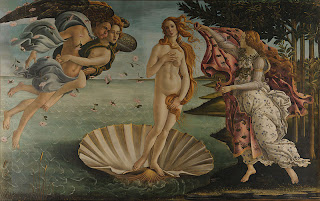 |
| Ponte Vecchio, Florence, Italy Photo from Wiki Commons |
The Ponte Vecchio is unique in that it does not maintain the same symmetrical balance of Florence’s architecture that shares a similar date. What makes the Ponte Vecchio so unique is its protruding structures. Small storefronts extend out over the Arno River with no particular pattern. Sparsely placed, these structures make the bridge, as a whole, look unfinished, but beautiful in its unique off-balanced unity. “You could call Ponte Vecchio a pasticcio, a mish-mash, or at least an arrangement of contradictory architectural notes" (Pridmore). The varied colors of the protruding structures make them the focal point of the asymmetrical bridge. The mechanical aspect of the bridge is quite linear and rhythmic; it consists of three arches, the center arch slightly longer than its neighboring arches. The variety exists in the extended structures. The functional portion of the bridge is what maintains unity. “Ponte Vecchio's architecture of countless fragments reflects this city's incalculable memory or, more simply, its lovely imperfections touch deep emotions" (Pridmore).
Essay by Georgia Button and Kate Logue.
Bibliography
Pridmore, Jay. "Ponte Vecchio, a Bridge That Spans Centuries." The Wall Street
Journal: n. pag. Web. 28 Nov. 2012. <http://online.wsj.com/article/
SB10001424052748704717004575268933589711578.html>.
This article from the Wall Street Journal: Europe Edition gives a brief overview of the history and architecture of the Ponte Vecchio, discussing its form as well as its function.
The Earliest Guide to Florentine Architecture, 1423. Florence:
Kunsthistorisches Institut, 1969. JSTOR. Web. 28 Nov. 2012.
<http://www.jstor.org/stable/10.2307/27652221>.
This book, found on JSTOR, covers Florentine Architecture and features a small but informative section about the Ponte Vecchio, utilizing primary sources and scholarly information.












